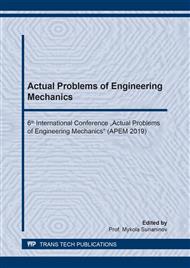p.460
p.468
p.475
p.486
p.496
p.511
p.519
p.528
p.534
Mathematical Theory of Transversally Isotropic Shells of Arbitrary Thickness at Static Load
Abstract:
Classical and non-classical refined theories of plates and shells, based on various hypotheses [1-7], for a wide class of boundary problems, can not describe with sufficient accuracy the SSS of plates and shells. These are boundary problems in which the plates and shells undergo local and burst loads, have openings, sharp changes in mechanical and geometric parameters (MGP). The problem also applies to such elements of constructions that have a considerable thickness or large gradient of SSS variations. The above theories in such cases yield results that can differ significantly from those obtained in a three-dimensional formulation. According to the logic in such theories, the accuracy of solving boundary problems is limited by accepted hypotheses and it is impossible to improve the accuracy in principle. SSS components are usually depicted in the form of a small number of members. The systems of differential equations (DE) obtained here have basically a low order. On the other hand, the solution of boundary value problems for non-thin elastic plates and shells in a three-dimensional formulation [8] is associated with great mathematical difficulties. Only in limited cases, the three-dimensional problem of the theory of elasticity for plates and shells provides an opportunity to find an analytical solution. The complexity of the solution in the exact three-dimensional formulation is greatly enhanced if complex boundary conditions or physically nonlinear problems are considered. Theories in which hypotheses are not used, and SSS components are depicted in the form of infinite series in transverse coordinates, will be called mathematical. The approximation of the SSS component can be adopted in the form of various lines [9-16], and the construction of a three-dimensional problem to two-dimensional can be accomplished by various methods: projective [9, 14, 16], variational [12, 13, 15, 17]. The effectiveness and accuracy of one or another variant of mathematical theory (MT) depends on the complex methodology for obtaining the basic equations.
Info:
Periodical:
Pages:
496-510
Citation:
Online since:
August 2019
Authors:
Price:
Сopyright:
© 2019 Trans Tech Publications Ltd. All Rights Reserved
Share:
Citation:


